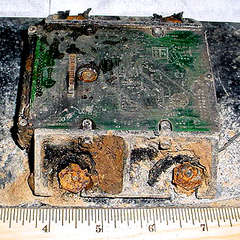Winchester data recovered from shuttle Columbia crashed in 2003
 It was a heartbreaking video footage of 2003 when the Columbia Space Shuttle, with seven astronauts on board, caught fire and fell apart in the air a few minutes before landing. The accident occurred about 500 miles from the launch site at Cape Canaveral in Florida.
It was a heartbreaking video footage of 2003 when the Columbia Space Shuttle, with seven astronauts on board, caught fire and fell apart in the air a few minutes before landing. The accident occurred about 500 miles from the launch site at Cape Canaveral in Florida.  Among the fragments of Colombia, which were carefully collected, was a Seagate hard drive with a capacity of 400MB, or rather what was left of it, since after a fire and falling to the ground from a great height, little could survive. On this hard drive was the information necessary to complete the physical experiment - CVX-2, which took place on the doomed mission of the Shuttle.
Among the fragments of Colombia, which were carefully collected, was a Seagate hard drive with a capacity of 400MB, or rather what was left of it, since after a fire and falling to the ground from a great height, little could survive. On this hard drive was the information necessary to complete the physical experiment - CVX-2, which took place on the doomed mission of the Shuttle.The Johnson Space Center staff analyzing the shuttle crash handed over these fragments of the hard drive to the engineers of the CVX-2 (Critical Viscosity of Xenon) experiment, which in turn handed them over to the Kroll Ontrack in Minneapolis, state Minnesota to find out if it’s possible to recover at least some data. For researcher Robert Berg and his team, this was the only, but very weak hope, of saving significant data from an experiment that examined Xeon's gas flows under microgravity conditions.
The Kroll Ontrack people managed to recover about 90 percent of 400 MB of hard drive data with a charred and broken case. A few years later, Robert Berg and his team analyzed the data and published the results of the experiment in the April issue of the journal (Physical Review E journal).
These showed that, rather liked whipped cream which changes from a fluid to a near-solid after being whipped or stirred vigorously, the gas Xenon change its viscosity from gas to liquid when similarly treated in very low gravity. The phenomenon of a sudden change in viscosity is called shear thickening. (Inducing or introducing shear to a fluid (gas or liquid) increases its viscosity and the substance behaves as a 'non-Newtonian' fluid.)This experiment showed that, as in the case of whipped cream, which transitions from a liquid state to a state close to solid, after they are whipped or shaken vigorously, Xenon gas goes into a liquid state if manipulated with light gravity. The phenomenon of sudden changes in the viscosity of a substance is called shear thickening. (Inducing or making a shift over a fluid (gas or liquid) increases its viscosity and the substance behaves like a non-Newtonian fluid).
It was a very complex experiment, requiring further and detailed analysis of data from the hard drive in order to discover the “subtle” effect, which was ultimately found, like the hard drive. Thus ends the twenty-year research work and at the same time puts an end to the terrible history of the mission of the Shuttle of Colombia.
Source (in English): blocksandfiles.com/article/5056
PS: I leave the physical studies without translation, since with physics I have a little Russian.
UPD: Thanks to sylvio and Kaberc for their help with the translation.
